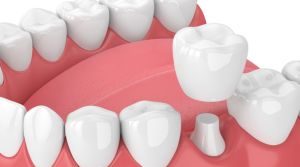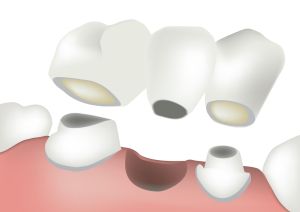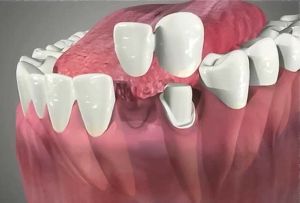
Crowns
A Crown is a type of Dental restoration which completely Caps or encircles a Tooth. In other words it is a Tooth-shaped “Cap” that is placed over a Tooth — to cover the Tooth to restore its Shape and Size, Strength, and improve its appearance.Crowns are used to cover Teeth that are weakened by decay, severely damaged, chipped or discolored.
A dental crown or dental cap is a custom made restoration that covers a tooth with sustained significant loss of structure. They are analogical to being a thimble capped over your finger. Dental crowns are used to restore teeth to a certain shape and size. They provide strength and improves the appearance of the tooth.
Benefits of Dental Crowns:-
Protects severely damaged tooth or tooth weakened by decay, fracture, large fillings or root canal therapy from fracturing. Teeth with large fillings tend to “flex more” forcing the tooth apart possibly causing stress fractures.
- Holds together cracked or weaken teeth and seal the tooth from decay.
- Covers discolored and irregularities in teeth in improving cosmetic appearance.
- Helps preserve the natural function and position of the teeth.
- Restores tooth with large decay, cavities or filings.
- Supports the replacement teeth in a bridge.
- Restores and maintains natural bite.
- Covers a dental implant.
Type of dental crowns:
- Metal crowns
- Porcelain-fused-to-metal crowns
- Metal Free (Zirconia)


Metal crowns
Metal crowns
These cowns can be made from cast gold alloys or cast silver palladium alloys. With a metal crown, less tooth structure needs to be removed and the wear on opposing teeth is minimal. Metal crowns withstand biting and chewing well and last the longest. They also rarely chip or break.

Porcelain-fused-to-metal crowns
Porcelain-fused-to-metal crowns
These dental crowns contain an inner metal casting with porcelain baked over it. They look natural and can be very aesthetic. Occasionally they may chip and show the underlying metal. Most porcelain crowns are slightly more abrasive and may wear the natural enamel of the opposing teeth.

Metal Free (Zirconia)
Metal Free (Zirconia)
Strength no longer has to be compromised to achieve extreme esthetics.Zirconia is like a much awaited CHANGE over traditional P.F.M in the present dental world.
Zirconia combines the esthetics of our patients demand with the strength and affordable prices they desire.
Laboratory tests have shown the fracture toughness and flexural strength of zirconia is significantly higher than that of alumina or any other all ceramic. Excellent strength and versatility can be achieved.
Procera Zirconia, made of Yttria Stabilized Zirconium (YZ) has substantial advantages compared to other dental materials: mechanical resistance, biocompatibility and a fracture toughness two times greater than Alumina.
Conventional precious metal ceramics restorations are at 800 MPa or less. Metal ceramics cannot compete with the esthetics of Procera Zirconia. It is capable of being placed anywhere in the mouth and can accommodate 3-4 unit bridges.
Procera Zirconia restorations can be inserted using conventional cementing techniques. Bonding is not required.
Bridges
A dental bridge is one method to fill a gap created by a missing tooth (or teeth). Dental bridge or pontic is a custom-made false tooth or teeth, that is permanently placed between two healthy teeth, filling in the area left by a missing tooth or teeth. The bridge is held in place by crowns placed on the healthy teeth on each side of space to be filled.
Benefits of Dental Bridges:-
- Restores your smile.
- Restores your ability to properly chew and speak.
- Maintains the shape of your face.
- Distributes the forces in your bite properly by replacing missing teeth.
- Prevents remaining teeth from drifting out of position.
- Helps preserve the natural function and position of the teeth.
- Restores and maintains natural bite
Type of dental bridges:
- Traditional bridges
- Cantilever bridges
- Maryland bridges


Traditional bridges
Traditional bridges
Traditional bridges involve creating a crown for the tooth or implant on either side of the missing tooth, with a pontic in between. Traditional bridges are the most common type of bridge.

Cantilever bridge
Cantilever bridge
Cantilever bridges are usually used when there are adjacent teeth on only one side of the missing tooth or teeth.

Maryland bridges
Maryland bridges
Marlyland bridges also called a resin-bonded bridges or a Maryland bonded bridges. Maryland bridges supported by a metal framework. Metal wings on each side of the bridge are bonded to the back of existing teeth.
ADDRESS 1
Abha Tooth World
Janta Colony,
Near Chandra Medicos,
Vaishali Nagar,
Ajmer- 305001(Rajasthan), India.
Phone No: +91-8003217749
Email ID: Mohit07oblivion@gmail.com
Address 2
Abha Tooth World
Near Murjani Medicos,
Panchsheel B Block,
Panchsheel,
Ajmer - 305001(Rajasthan), India.
Phone No: +91-8003217749
EmailID:Mohit07oblivion@gmail.com
